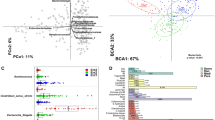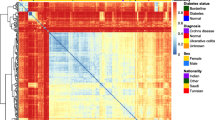Abstract
Several studies have shown associations between groups of intestinal bacterial or specific ratios between bacterial groups and various disease traits. Meanwhile, little is known about interactions and associations between eukaryotic and prokaryotic microorganisms in the human gut. In this work, we set out to investigate potential associations between common single-celled parasites such as Blastocystis spp. and Dientamoeba fragilis and intestinal bacteria. Stool DNA from patients with intestinal symptoms were selected based on being Blastocystis spp.-positive (B+)/negative (B−) and D. fragilis-positive (D+)/negative (D−), and split into four groups of 21 samples (B+ D+, B+ D−, B− D+, and B− D−). Quantitative PCR targeting the six bacterial taxa Bacteroides, Prevotella, the butyrate-producing clostridial clusters IV and XIVa, the mucin-degrading Akkermansia muciniphila, and the indigenous group of Bifidobacterium was subsequently performed, and the relative abundance of these bacteria across the four groups was compared. The relative abundance of Bacteroides in B– D– samples was significantly higher compared with B+ D− and B+ D+ samples (P < 0.05 and P < 0.01, respectively), and this association was even more significant when comparing all parasite-positive samples with parasite-negative samples (P < 0.001). Additionally, our data revealed that a low abundance of Prevotella and a higher abundance of Clostridial cluster XIVa was associated with parasite-negative samples (P < 0.05 and P < 0.01, respectively). Our data support the theory that Blastocystis alone or combined with D. fragilis is associated with gut microbiota characterized by low relative abundances of Bacteroides and Clostridial cluster XIVa and high levels of Prevotella.



Similar content being viewed by others
References
Zoetendal EG, Akkermans AD, De Vos WM (1998) Temperature gradient gel electrophoresis analysis of 16S rRNA from human fecal samples reveals stable and host-specific communities of active bacteria. Appl Environ Microbiol 64:3854–3859
Qin J, Li R, Raes J et al (2010) A human gut microbial gene catalogue established by metagenomic sequencing. Nature 464:59–65
Jiménez E, Fernández L, Marín ML, Martín R, Odriozola JM, Nueno-Palop C, Narbad A, Olivares M, Xaus J, Rodríguez JM (2005) Isolation of commensal bacteria from umbilical cord blood of healthy neonates born by cesarean section. Curr Microbiol 51:270–274
Ottman N, Smidt H, de Vos WM, Belzer C (2012) The function of our microbiota: who is out there and what do they do? Front Cell Infect Microbiol 2:104
Aziz Q, Doré J, Emmanuel A, Guarner F, Quigley EM (2013) Gut microbiota and gastrointestinal health: current concepts and future directions. Neurogastroenterol Motil 25:4–15
Rajilić-Stojanović M, de Vos WM (2014) The first 1000 cultured species of the human gastrointestinal microbiota. FEMS Microbiol Rev 38:996–1047
Gerritsen J, Smidt H, Rijkers GT, de Vos WM (2011) Intestinal microbiota in human health and disease: the impact of probiotics. Genes Nutr 6:209–240
Arumugam M, Raes J, Pelletier E et al (2011) Enterotypes of the human gut microbiome. Nature 473:174–180
Andersen LO, Vedel Nielsen H, Stensvold CR (2013) Waiting for the human intestinal Eukaryotome. ISME J 7:1253–1255
Lukeš J, Stensvold CR, Jirků-Pomajbíková K, Wegener Parfrey L (2015) Are human intestinal eukaryotes beneficial or commensals? PLoS Pathog 11:e1005039
Krogsgaard LR, Engsbro AL, Stensvold CR, Nielsen HV, Bytzer P (2015) The prevalence of intestinal parasites is not greater among individuals with irritable bowel syndrome: a population-based case–control study. Clin Gastroenterol Hepatol 13:507.e502–513.e502
Rossen NG, Bart A, Verhaar N, van Nood E, Kootte R, de Groot PF, D’Haens GR, Ponsioen CY, van Gool T (2015) Low prevalence of Blastocystis sp. in active ulcerative colitis patients. Eur J Clin Microbiol Infect Dis 34:1039–1044
Petersen AM, Stensvold CR, Mirsepasi H, Engberg J, Friis-Møller A, Porsbo LJ, Hammerum AM, Nordgaard-Lassen I, Nielsen HV, Krogfelt KA (2013) Active ulcerative colitis associated with low prevalence of Blastocystis and Dientamoeba fragilis infection. Scand J Gastroenterol 48:638–639
Clemente JC, Ursell LK, Parfrey LW, Knight R (2012) The impact of the gut microbiota on human health: an integrative view. Cell 148:1258–1270
Andersen LO, Bonde I, Nielsen HB, Stensvold CR (2015) A retrospective metagenomics approach to studying Blastocystis. FEMS Microbiol Ecol 91. doi:10.1093/femsec/fiv072
Stensvold CR, Ahmed UN, Andersen LO, Nielsen HV (2012) Development and evaluation of a genus-specific, probe-based, internal-process-controlled real-time PCR assay for sensitive and specific detection of Blastocystis spp. J Clin Microbiol 50:1847–1851
Verweij JJ, Mulder B, Poell B, van Middelkoop D, Brienen EA, van Lieshout L (2007) Real-time PCR for the detection of Dientamoeba fragilis in fecal samples. Mol Cell Probes 21:400–404
Mackie RI, Sghir A, Gaskins HR (1999) Developmental microbial ecology of the neonatal gastrointestinal tract. Am J Clin Nutr 69:1035S–1045S
Tannock GW, Tilsala-Timisjarvi A, Rodtong S, Ng J, Munro K, Alatossava T (1999) Identification of Lactobacillus isolates from the gastrointestinal tract, silage, and yoghurt by 16S-23S rRNA gene intergenic spacer region sequence comparisons. Appl Environ Microbiol 65:4264–4267
Bergström A, Licht TR, Wilcks A, Andersen JB, Schmidt LR, Grønlund HA, Vigsnaes LK, Michaelsen KF, Bahl MI (2012) Introducing GUt low-density array (GULDA): a validated approach for qPCR-based intestinal microbial community analysis. FEMS Microbiol Lett 337:38–47
Tukey JW (1949) Comparing individual means in the analysis of variance. Biometrics 5:99–114
Blair RC, Higgins JJ (1980) A comparison of the power of Wilcoxon’s rank-sum statistic to that of Student’s t statistic under various nonnormal distributions. J Educ Stat 5:24
Claesson MJ, Cusack S, O’Sullivan O et al (2011) Composition, variability, and temporal stability of the intestinal microbiota of the elderly. Proc Natl Acad Sci USA 108(Suppl 1):4586–4591
Roager HM, Licht TR, Poulsen SK, Larsen TM, Bahl MI (2014) Microbial enterotypes, inferred by the prevotella-to-bacteroides ratio, remained stable during a 6-month randomized controlled diet intervention with the new nordic diet. Appl Environ Microbiol 80:1142–1149
Bergström A, Skov TH, Bahl MI, Roager HM, Christensen LB, Ejlerskov KT, Mølgaard C, Michaelsen KF, Licht TR (2014) Establishment of intestinal microbiota during early life: a longitudinal, explorative study of a large cohort of Danish infants. Appl Environ Microbiol 80:2889–2900
Stensvold CR, Smith HV, Nagel R, Olsen KE, Traub RJ (2010) Eradication of Blastocystis carriage with antimicrobials: reality or delusion? J Clin Gastroenterol 44:85–90
Acknowledgments
Author contributions
Lee O’Brien Andersen (LOA), Amanj Baker Karim (ABK), Henrik Munch Roager (HMR), Louise Kristine Vigsnæs (LKV), Karen Angeliki Krogfelt (KAK), Tine Rask Licht (TRL), Christen Rune Stensvold (CRS). The first person listed in each section is the responsible author.
Study conception and design: CRS, TRL, KAK, ABK and LOA. Acquisition of data: ABK, HMR, LKV, TRL, CRS and LOA. Analysis and interpretation of data: LOA, ABK, HMR, CRS, KAK and TRL. Drafting of manuscript: LOA and CRS. Critical revision: All
Author information
Authors and Affiliations
Corresponding author
Ethics declarations
Funding
Lee O’Brien Andersen’s work is partly supported by the Lundbeck Foundation (Project no. R108-A10123). Christen Rune Stensvold’s work is partly funded by Marie Curie Actions (CIG Project no. PCIG11-GA-2012-321614).
Conflict of interest
All authors report of no conflict of interests.
Informed consent
Formal consent was not required as this was a retrospective observational study.
Rights and permissions
About this article
Cite this article
O’Brien Andersen, L., Karim, A.B., Roager, H.M. et al. Associations between common intestinal parasites and bacteria in humans as revealed by qPCR. Eur J Clin Microbiol Infect Dis 35, 1427–1431 (2016). https://doi.org/10.1007/s10096-016-2680-2
Received:
Accepted:
Published:
Issue Date:
DOI: https://doi.org/10.1007/s10096-016-2680-2




